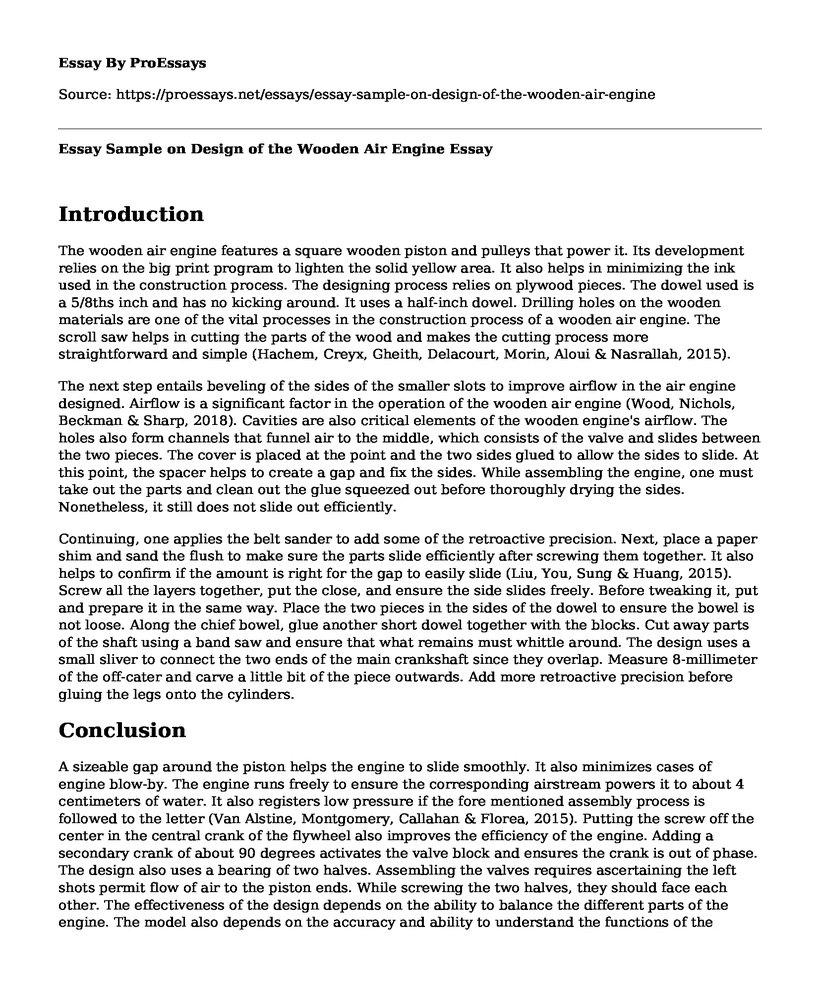Introduction
The wooden air engine features a square wooden piston and pulleys that power it. Its development relies on the big print program to lighten the solid yellow area. It also helps in minimizing the ink used in the construction process. The designing process relies on plywood pieces. The dowel used is a 5/8ths inch and has no kicking around. It uses a half-inch dowel. Drilling holes on the wooden materials are one of the vital processes in the construction process of a wooden air engine. The scroll saw helps in cutting the parts of the wood and makes the cutting process more straightforward and simple (Hachem, Creyx, Gheith, Delacourt, Morin, Aloui & Nasrallah, 2015).
The next step entails beveling of the sides of the smaller slots to improve airflow in the air engine designed. Airflow is a significant factor in the operation of the wooden air engine (Wood, Nichols, Beckman & Sharp, 2018). Cavities are also critical elements of the wooden engine's airflow. The holes also form channels that funnel air to the middle, which consists of the valve and slides between the two pieces. The cover is placed at the point and the two sides glued to allow the sides to slide. At this point, the spacer helps to create a gap and fix the sides. While assembling the engine, one must take out the parts and clean out the glue squeezed out before thoroughly drying the sides. Nonetheless, it still does not slide out efficiently.
Continuing, one applies the belt sander to add some of the retroactive precision. Next, place a paper shim and sand the flush to make sure the parts slide efficiently after screwing them together. It also helps to confirm if the amount is right for the gap to easily slide (Liu, You, Sung & Huang, 2015). Screw all the layers together, put the close, and ensure the side slides freely. Before tweaking it, put and prepare it in the same way. Place the two pieces in the sides of the dowel to ensure the bowel is not loose. Along the chief bowel, glue another short dowel together with the blocks. Cut away parts of the shaft using a band saw and ensure that what remains must whittle around. The design uses a small sliver to connect the two ends of the main crankshaft since they overlap. Measure 8-millimeter of the off-cater and carve a little bit of the piece outwards. Add more retroactive precision before gluing the legs onto the cylinders.
Conclusion
A sizeable gap around the piston helps the engine to slide smoothly. It also minimizes cases of engine blow-by. The engine runs freely to ensure the corresponding airstream powers it to about 4 centimeters of water. It also registers low pressure if the fore mentioned assembly process is followed to the letter (Van Alstine, Montgomery, Callahan & Florea, 2015). Putting the screw off the center in the central crank of the flywheel also improves the efficiency of the engine. Adding a secondary crank of about 90 degrees activates the valve block and ensures the crank is out of phase. The design also uses a bearing of two halves. Assembling the valves requires ascertaining the left shots permit flow of air to the piston ends. While screwing the two halves, they should face each other. The effectiveness of the design depends on the ability to balance the different parts of the engine. The model also depends on the accuracy and ability to understand the functions of the various parts of the machine.
References
Hachem, H., Creyx, M., Gheith, R., Delacourt, E., Morin, C., Aloui, F., & Nasrallah, S. B. (2015). Comparison Based on Exergetic Analyses of Two Hot Air Engines: A Gamma Type Stirling Engine and an Open Joule Cycle Ericsson Engine. Entropy, 17(11), 7331-7348.
Liu, C. M., You, J. J., Sung, C. K., & Huang, C. Y. (2015). Modified intake and exhaust system for piston-type compressed air engines. Energy, 90, 516-524.
Van Alstine, D. G., Montgomery, D. T., Callahan, T. J., & Florea, R. C. (2015, November). Ability of the Methane Number Index of a Fuel to Predict Rapid Combustion in Heavy Duty Dual Fuel Engines for North American Locomotives. In ASME 2015 Internal Combustion Engine Division Fall Technical Conference (pp. V001T02A010-V001T02A010). American Society of Mechanical Engineers.
Wood, M. W., Nichols Jr, J. P., Beckman, K. R., & Sharp, T. B. (2018). U.S. Patent Application No. 15/610,023.
Cite this page
Essay Sample on Design of the Wooden Air Engine. (2022, Apr 12). Retrieved from https://proessays.net/essays/essay-sample-on-design-of-the-wooden-air-engine
If you are the original author of this essay and no longer wish to have it published on the ProEssays website, please click below to request its removal:
- BMW Are the Best Cars
- The Environmental Effects of Oil and Natural Gas Extraction Through Hydraulic Fracturing
- Critical Article Analysis Essay on Vision 2030
- Essay Sample on Turbo Machinery
- Essay Sample on Crude Oil: A Limited Resource Essential for Industrial Needs
- Essay Example on Ergonomics: Applied Science for Safe & Efficient Human Interaction
- Commodities Storage & Transportation: Biggest Challenges Ahead - Essay Sample







